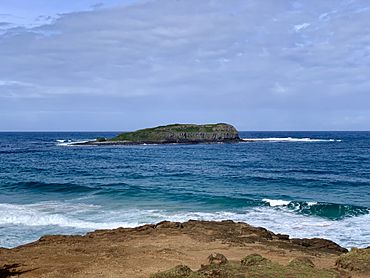Cook Island Aquatic Reserve facts for kids
Quick facts for kids Cook Island Aquatic ReserveNew South Wales |
|
|---|---|

Cook Island as seen from Fingal Head
|
|
| Established | 23 October 1998 |
| Area | 74 hectares (180 acres) |
| Managing authorities | Department of Primary Industries |
| Website | Cook Island Aquatic Reserve |
The Cook Island Aquatic Reserve is a special protected area in the South Pacific Ocean. It is located around Cook Island. This island is about 600 meters (about 2,000 feet) from the Fingal Head mainland in New South Wales, Australia. This reserve helps protect the amazing sea creatures and their homes around the island.
Contents
Cook Island Aquatic Reserve
The Cook Island Aquatic Reserve was created on October 23, 1998. It covers about 74 hectares (about 183 acres) of water. This area extends up to 500 meters (about 1,640 feet) from a special marker on the island. The reserve is managed by the Department of Primary Industries.
Exploring the Reserve's Zones
The aquatic reserve has two main areas, or "zones," to help protect marine life:
- No-Fishing Zone: This area is closest to Cook Island. It stretches from the island's high tide mark out to a boundary marked by five special buoys. In this zone, no fishing is allowed at all. This helps fish and other sea animals grow and thrive without being disturbed.
- Line Fishing Only Zone: This zone is outside the buoys and goes to the outer edge of the reserve. In this area, some types of fishing are allowed, but only with a fishing line. This helps balance protection with recreational activities.
Fun Activities at Cook Island
Many people enjoy visiting the Cook Island Aquatic Reserve. It's a great place for:
- Swimming: The clear waters are perfect for a dip.
- Boating: People can enjoy being out on the water.
- Diving: Divers love to explore the underwater world here.
To help protect the seabed, there are 13 special moorings for boats. This means boats can tie up without dropping anchors, which can damage the delicate ocean floor.
Amazing Marine Life
The waters around Cook Island are full of incredible sea creatures. You might see many different kinds of fish, such as:
- Anemonefish
- Bullseyes
- Groupers
- Leatherjackets
- Parrotfish
- Pufferfish
- Surgeonfish
- Sweetlips
- Trevally
The reserve is also a popular spot for different types of sharks. These include blind sharks, leopard sharks, and wobbegongs. Other fascinating animals living here are:
In 2009, experts from the Tweed Shire Council noted that Cook Island is a very important home for sharks.
How Cook Island is Protected
The Cook Island Aquatic Reserve is recognized internationally for its protection efforts. It follows the International Union for Conservation of Nature (IUCN) system.
- The no-fishing zone is like an IUCN Category II area, similar to a national park. This means it's highly protected for its ecosystems.
- The line fishing only zone is like an IUCN Category IV area. This means it's managed to protect specific habitats and species.


